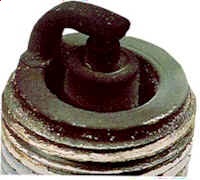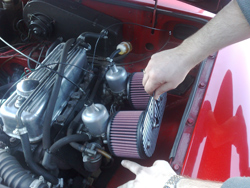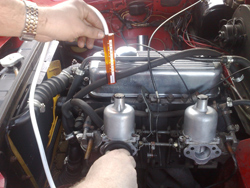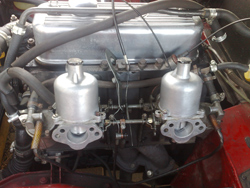The SU carburettor is a relatively simple design but has proved to be very effective. The often underrated SU offers good versatility and reliability.
SU carburettors can theoretically perform better than modern computer controlled fuel systems. This is due the SU being analogue and the vast array of needle profiles available.
Inside the body of the carburettor is a piston, which reacts to the rate of air flow into the engine. Attached to the piston is a tapered needle which alters the amount of fuel delivered as it rises and falls. This combination provides variable amounts of fuel and air to cope with the demands of the engine under changing loads.
SU carburettors are very simple to adjust, but please resist the temptation to fiddle with them unnecessarily.
If your engine is not running correctly, always check your ignition system first of all as this is the problem in most cases.
Most engine problems are caused by incorrect timing or points out of adjustment. You should only adjust your caburettors when you are completely satisfied that the ignition system is working correctly (if you have a vacuum gauge fitted then you can tune your ignition timing as described in this article) . Only then can you turn your attention to the carburettors.
Checking adjustment
The colour of the spark plug electrodes and the colour of the exhaust tailpipe provides the most visible and easily checked guide as to how well your carburettors are adjusted. Take your classic for a run and thoroughly warm up the engine, then remove each plug in turn and compare the colour of its electrode with the chart below
Combustion deposits are slight and not heavy enough to cause any detrimental effect . Note the brown to greyish tan colour, and minimal amount of electrode erosion .

Rich Mixture
Soft, black, sooty deposits easily identify this plug condition. This is most often caused by an over-rich, air/fuel mixture.
Check for a sticking choke, clogged air cleaner, or a carburetor problem - float level high, defective needle or seat, etc
Carburettor adjustment
Twin SU’s are straightforward to set up, with just three main areas of adjustment.
These are:
- synchronising the carburettors
- adjusting the mixture
- setting the idle speed
Before attempting to make any of these adjustments, start the engine and run it until it reaches normal operating temperature, then remove the air filters.

Synchronising twin carburettors
To achieve the best possible performance from your classic you will need to synchronise the both carburettors.
Start the engine and run until warm. You can then adjust the throttle idling screws on each carburettor to give the desired idling speed. You should set the engine idle speed as low as possible, but keep it fast enough for the engine to run reasonably smoothly.
With the engine still running use a length of rubber tube to listen to the intake 'hiss' from each carburettor. Compare the hissing sound made by the air being sucked into each carburettor (It is important to be consistent about where you position the rubber pipe, when you measure the hiss from each carburettor in turn). Carbalancer from Gunson provides a more accurate visual version using a flow meter and an adjustable head which fits into the throat of the carburettor.

You should measure the hiss/flow and adjust the throttle screws until it is the same for each carburettor, You can now adjust the idle speed by turning both throttle screws by the same amount. Once the desired idle speed is achieved it is worth checking again to make sure the flow rate is still balanced.
Adjusting the mixture
If a check of the colour of the spark plug electrodes reveals the need to adjust the mixture, now is the time to do it.
On most models, the jet adjusting nut is clearly visible beneath the body of the carburettor. Turning this adjusting nut upwards (tightening) will weaken the mixture and turning it downwards (loosening) will make the mixture richer. You can obtain an SU jet adjusting spanner to make this adjustment easier. If your mixture is really badly adjusted you can tighten the adjusting nut up fully and then loosen it 12 flats of the nut. This will set your mixture to approximately the correct place.
On an HIF carburettor the mixture adjustment is by a cross head screw situated in a recess in the base of the body
On later cars, jet adjustment is controlled by turning a screw on the side of the body of the instrument. Turning the screw clockwise will enrich the mixture, while turning the screw in an anti-clockwise direction will weaken the mixture.
Carburettor lifting pins
At the side of each carburettor is a lifting pin, these pins enable you to check the movement of the piston.
Once the carburettors have been synchronised, the lifting pins can be used to check the mixture adjustment. Raise the lifting pin on the front carburettor to lift the piston by approximately 1/32 in (0.8mm).
- If the engine speed increases, the mixture strength of the carburettor is too rich.
- If the engine speed immediately decreases, the mixture strength of the carburettor is too weak.
- If the engine speed momentarily increases very slightly then returns to idle, then mixture strength at the carburettor is correct.
If the exhaust note is irregular with a slight of misfire and colourless exhaust, the mixture is too weak. If there is a regular misfire in the exhaust beat, together with a blackish exhaust, then the mixture is too rich.
Damper oil
Top up each of the piston dampers with carburettor damper oil. Unscrew the damper cap, withdraw the damper and top up the reservoir until the oil level is 1/2 in (12mm) above the top of the hollow piston rod.

Float chambers
The float chamber of the carburettor contains a float and a needle valve. The float works rather like a ball valve (just like the one in your toilet). As the level of fuel in the float chamber falls, the needle opens and allows in more fuel. If the float sticks or becomes punctured, fuel will continue to enter the chamber and eventually pour out of the overflow pipe. Sometimes the needle valve itself can become blocked or stuck and will either not allow any fuel to pass or fail to shut off and fuel will overflow. Early cars will have the float chambers mounted at the side of the carburettors but on later cars the float chambers are built-in to the main body.
Butterfly valves
Some cars may have carburettors fitted with overrun depression limiting valves fitted to the butterfly or throttle disc. The idea behind these valves was to clean up exhaust emissions by drawing in more air on the overrun. If the springs become weak and the valves fail to close properly an erratic tick over with a rising idle speed will result. This can be remedied by replacing the valves with new ones or by reverting the earlier specification butterflies without the overrun depression valves (recommended)
[via: classiccarhub.co.uk]